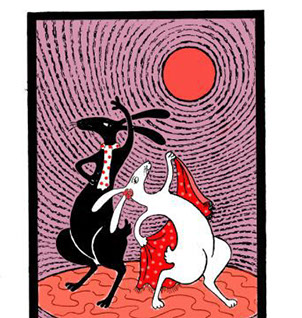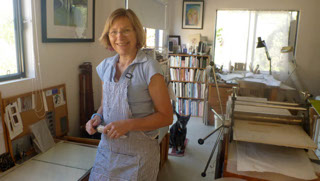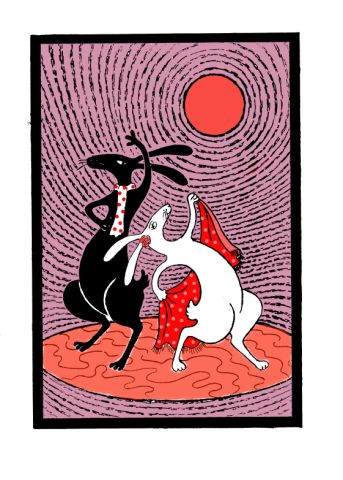

Against Modernism: An Interview With The Australian Painter Julia Wakefield
By: Saleh Razzouk
Julia Wakefield has interests in either paintings or poetry, some times in both together, where she illustrates what she writes with vivid colours and fluid lines.
she reflects in both her painting and her poetry two aspects of her inner life: her love of drawing from life and observing nature, as well as her obsession with imaginary animals that express human emotions.
In other words she uses animals in order to send the message that is behind the images.
Her animals have human characteristics and mostly are happy but never fierce nor dangerous.
Julia Wakefield was born in England and now lives in Australia. She is married with three children. And makes a living from teaching drawing and printmaking to adults.
On her concepts on Painting, Printing and poetry we had this interview.
-----
*You draw, print and write. Do you think one sort of expression helps to enhance the others?.
- I draw either to increase my understanding of the visual world or to try to make sense of what I see in my head.
I make prints to make my drawing less literal - the process of transforming the drawing into a print often takes the image in unexpected directions. I never have a clear idea of what the print will eventually look like.
The poetry is a way of communicating ideas that the visual medium can't convey - words can conjure sounds, smells and the sense of touch, as well as describing feelings associated with the five senses. I find myself telling stories in all three media, so it was natural for me to illustrate children's books when I started out as an illustrator.
-----
*What is more close to you, the visual or the written arts? Why.
- I have finally decided that both media are equally important to me, but at times it is difficult to strike a balance.
I found it very hard to choose between the two when I was growing up. My father wrote stories and turned them into a cartoon strip, so I thought I would probably do something similar. But I felt I needed to concentrate on the visual side after leaving school, where the teaching emphasis was always on writing, so I spent four years at art school and avoided academic study as much as possible. It took me a long time to regain my confidence in writing, but I realised that was because I was trying to write children's picture books, and I felt I didn't have enough experience as a writer compared with my experience as an illustrator. As soon as I took up poetry seriously, I discovered I didn't have to connect this medium directly with images, so I was able to focus on it 100% and didn't feel anyone would challenge my abilities. Many people know me as a poet but don't realise I'm a visual artist, and the reverse is true as well.
-----
*What papers your father worked for?.
- He wrote and illustrated a daily strip for the News Chronicle, the Daily Mail, and finally the Guardian. He drew political cartoons for the New Statesman. When he returned to Australia he drew for the Melbourne Age.
https://en.wikipedia.org/wiki/Arthur_Horner_(cartoonist)
https://www.cartoons.ac.uk/artists/arthurhorner/biography
------
*What was his qualification?.
- He was very successful at school and could have gone to university, but he chose to go to Sydney Tech where he studied Graphic Art. He met my mother in Sydney - she went to art school some years before he did as she was older than him. She actually left school at 14 and went straight to art school. They both read widely although they didn't have much academic higher education.
-----
*You use sharp colours in your pantings. Do you have an explanation. After second world war the whole attitude is very gray and bleak. If you have a look on the paintings of our time all wear dull colours except in Africans and Asians galleries where the sun is red and sky too blue.
- I actually love black and white. My father drew almost exclusively in black and white for newspapers, and I learned from him very early on that a political message is most successfully conveyed in black and white. He had books of etchings by Goya and lithographs by Daumier and Gavarni, which I admired long before I was old enough to understand the political messages. Goya's etchings are frightening and shocking, but I also love the etchings and black and white sketches of domestic scenes by artists like Rembrandt and Degas. As an illustrator I was encouraged to work in black and white for publications, but children's picture books are often brightly coloured. I had to learn how to use colour in combination with a black pen line, which was a fashionable style before computers revolutionised the publishing world.
My colours were still quite pale and muted until I moved to Australia, where the light is so bright, and so many of the birds and flowers are brilliantly coloured. My etchings and wood engravings are still often black and white or monochrome, but I now add strong colours to my linocuts and woodcuts in an attempt to convey the vibrancy of the world I find myself in. The rabbits in my work are black and white creatures but they are always playful and childlike, so they seem to demand a colourful world to live in.
-----
*Why you moved to Australia in first place. To work or for something else?.
- My parents moved back to Australia in 1976 and I followed three years later with my husband. We weren't sure if we were going to stay, but I had citizenship through my parents, so there was no problem about staying. In the end we went back to the UK twice, and the second time we stayed there until my daughter was ready for university. We realised it would be very expensive to put our three children through university in the UK, so we decided to come back to live in Adelaide, where the property prices were cheaper and the city felt more friendly than the bigger cities like Melbourne or Sydney. Most of my relatives live in Melbourne and Sydney but my parents passed away nearly 20 years ago.
-------
*Any particular memories on war time in England of any?.
- My parents arrived in England from Australia a year or two after the war, and all they can remember about those days was the rationing - Australia never had to struggle in the same way. My father was as a camouflage officer in Borneo during the war: he didn't see much action but he was part of the history unit and documented his experiences in his sketchbook as well as his journals. I only have a few drawings from those days. When he arrived in Europe he spent some time helping to rebuild the railways and roads, I'm not sure how!
*What kind of reminiscences you have about England. Apparently it left no trace in your work.
------
*Strange that Childhood have been erased so simply.
- I grew up first in London and then in a rural area just outside London. I had a very happy childhood and I loved the countryside, and I wanted to give our children a similar experience, so we lived in the country in Devon and Somerset when we went back to the UK after our first child was born. I have painted watercolours of English landscapes and I have some prints that I made that were inspired by English countryside, but nobody wants to buy them here! My rabbits are actually migrants, like me: I started drawing them in the UK and they came with me to Australia.
------
*For what you do chose mostly animals in human situations?.
- I remember drawing a stuffed bird when I was still at art school, and it seemed to jump out of the paper at me - it was suddenly alive again, and bristling with personality. I decided then that I was not a natural history painter, but I seem to have an ability to draw animals that reflect human emotions, and I'm not sure where the inspiration comes from, although I know my father was also able to put human personalities into his animal characters. The rabbits arrived in my head one day out of nowhere. I don't copy Disney animals and I have no interest in following fashion. I feel an emotion and I turn it into an animal.
-------
*what philosophy you adopt when you address the adults?.
- I have begun to realise that what I want to express in my drawings and prints is a wealth of emotions: some of my drawings make me laugh and I hope they can evoke the same feelings in other people, while I also like to frighten myself and others a little with some of my images, but I try to do it in a gentle way. I am currently working on a series of woodcuts of birds, and in those I want to express the awe I feel when I look at such beautiful, powerful flying creatures. I never think of my work as simply decorative, but I am very fussy about the design of my pictures.
------
*Who is your favorite painter. In and out Australia. Why?.
- My favourite all time painter is Rembrandt. I love his intimate drawings of his family, his wife Saskia sitting in a window, his beloved son Titus who was the only child who survived to adulthood, his wife dealing with a toddler's tantrum, the beggars he used to bring in off the street and posed as Biblical kings, his self portraits that document every emotion, every stage in his life from brash youth to frail old age, all the drawings done as part of his research for future historical paintings, but also every one of them is a perfect work of art.
My favourite Australian painter is probably Brett Whiteley - most of all because he's an amazing draftsman, but also because his colours are much brighter and bolder than mine can ever be - and he also has a great sense of humour. I also love a host of Australian cartoonists - my parents, Arthur Horner and Vic Cowdroy, taught me so much, but also Michael Leunig and his sister Mary Leunig, John Spooner (who is profoundly influenced by the Great Masters such as Goya) and Andrew Marlton, creator of First Dog on the Moon http://firstdogonthemoon.com.au/
------
*Who is your favorite writer in and out Australia?.
- Umberto Eco's 'the Name of the Rose' is one of the books that has had the most profound effect on me. I love mythologies from all cultures, and grew up not only with European fairy tales but with Aboriginal ones too, sent to me by my grandparents. I haven't yet found a favourite Australian author, I feel I have a lot of reading still to do, but David Malouf does a lot for me. I read his novel Fly away Peter. It's about a friendship between two young men just before the war. One of them is a bird watcher, the other is a rich man. His descriptions are very evocative. I've also read his stories of his own childhood. Australian childhoods are fascinating to me because I could have had one - but I had an English one instead.
------
*If you read now. Who, what. Why.???
- I have several different books on the go. I love reading different perspectives on the world, it shakes me out of my own narrow view of life. I read a lot of poetry by friends or recommended by friends. I love to read accounts of journeys, and there are so many accounts these days of people leaving one life to start again in a new culture, with all their previous values turned upside down. I also still enjoy mythologies, allegories that point out the pettiness and absurdities of our everyday life. Children's books are often the most profound poems of all. And I love to listen to the radio, especially the true stories about extraordinary people on BBC World service.
-------
*On printing. Do you use screen and dyes or the printer. What kind of material you use in printing. And how do you transfer it to the surfaces. How do you finish it and with what?.
- Most of my prints are woodblocks or etchings, printed either by hand or in an etching press. I have made screen prints, and I am experimenting these days with digital prints, sometimes combined with handmade prints. I sometimes start with a handmade print, scan it into the computer and print it on watercolour paper, then I paint over it. I often draw in black and white on paper, scan the drawing and then add digital colour before I print it. My other favourite medium is the monoprint - I roll ink onto glass, then draw into it with a rag, and print the image. I use this as a starting point for developing ideas.
-------
*Do you have a workshop. Could you describe it. What do you keep in it. Books or just tools?.
- It has books, tools, pictures, an etching press, a woodblock press and lots of work surfaces which I keep covering! I love the space because it has two double doors and two large windows, so there is plenty of light and it overlooks my garden. It's called Black Dog Studio after my dog, but no one could ever feel depressed in that space. I rarely bring my computer into that space, as it is for 'hands on' work only.
-------
*Do you think modernism succeeded in delivering the message or just enhanced the uncertainty of our fate and future. Or renaissance gave the humanity better ways of escape?.
- When I teach drawing, I show people the European cave paintings and tell them that we have made no artistic progress at all since the dawn of time. People embrace different artistic styles according to the needs of their culture. The extraordinary thing about modern times is that we are aware of so many artistic approaches now that there is no such thing as tradition any more. I look for the humanity in every cultural tradition, and I think that's what I try to communicate. I'm not interested in abstraction for its own sake, and realism has no significance for me - it's just another way of looking at the world. Picasso's Guernica makes absolute sense for me because it documents tragedy in a way that we can admire and identify with, without being overwhelmed. Art is not for me a means of escape from reality: both by doing it and by experiencing/looking at it, I am better able to understand and accept the unpleasant aspects of reality - and hopefully, somehow, it will teach us to be better people.
October 2015
writer from Syria
work from artist Julia Wakefield



design: gitta pardoel logo: modhir ahmed © ila-magazine